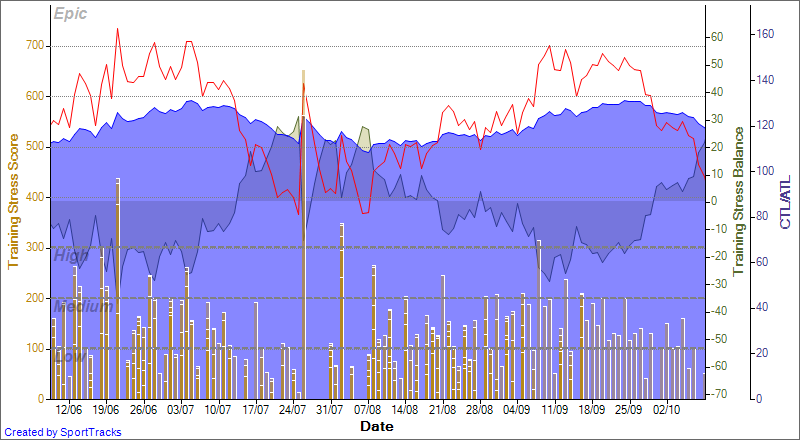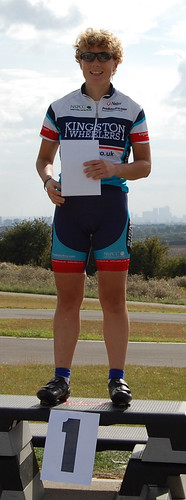Ultimately, I want to use the Performance Management Chart (PMC) to plan my workouts to help me achieve two things by race day:
1) TBS of about +20
2) CTL loss of about 10% from its highest point.
To this end, the first thing I did was plug my proposed workouts for the next three weeks into SportTracks, along with their projected TSS values. Incidentally I find SportTracks with the Training Load plugin way easier than WKO+ to work with; the calendar makes sense, the notes field lets me add stuff seamlessly, and the general UI and feel of the software is so much more intuitive. And since I'm using TSS/TRIMP values to determine my training load and stress balance (the plugin by default uses HR), the PMC will look the same in WKO+ as in SportTracks -- just nicer. :)
I got my projected TSS values by looking at past similar workouts in WKO+. For instance, I know that a long ride of ~100km/4hrs at an intensity factor of .70 will give me about 200 TSS points. Similarly, an hour-long run including some mile repeats gives me a TSS of 100 or so. Swims I generally use one TSS point per minute, less if I swim easy and more if I swim hard.
Three weeks of workouts, including the final two weeks of peaking/tapering from my Endurance Nation plan, plugged into SportTracks gives me this for my PMC:

projected CTL/ATL for October 10, 2009
That's a CTL of 119 (down roughly 10% from a projected high of 131 on Sept. 29) and an ATL of 97 to give me a TSB of 22 the day before race day. The TSB is a bit high maybe. But it's also likely that my workouts will feel a bit harder once I get to Kona as I'll need to acclimatise a bit, so having a bit extra on the TSB should be fine. Interesting to compare it to my LP taper (the big drop leading up to July 26) and see how it drops off more gradually and with fewer ATL spikes until the final week.
It's an interesting balance, tapering to shed enough fatigue without losing too much fitness. The problem is, as TSB rises, CTL decreases which can mean more than 10% fitness loss on race day. So which one is more important, keeping to a no-more-than 10% fitness loss, or having a TSB of +20? I think this is probably a problem for most athletes who carry a high CTL: the higher your TSS/day (which is what CTL is), the more you have to do to maintain it. And the more severely you taper and cut your volume, the more CTL drops compared to its absolute highest.
The highly analytical article from Coggan describing the art and science behind the PMC is here, but in my view the most important sentence is this:
in the Performance Manager concept, an individual’s CTL (and the “composition” of the training resulting in that CTL – see more below) determines their performance potential (at least within limits), but their TSB influences their ability to fully express that potential. Their actual performance at any point in time will therefore depend on both their CTL and their TSB, but determining how much emphasis to accord to each is now a matter of trial-and-error/experience, not science.But I think it's also important to keep in mind what ChuckieV has said about tapering and freshness (though I have to say he loses me with the "anyone training less than 15 hours a week only needs a few days of taper" bit!):
Quite often athletes erroneously aim for being "fresh" when Ironman day arrives, when they really just need to focus on being rested.Rested is what I'm going to have to be to put on my best performance. That means early to bed every night, naps if I need them, limiting the time spent on my feet doing touristy things and generally staying away from the hustle and bustle of 2000+ other Ironman athletes stressing about their race.

5 comments:
Ahaaa Chuckie V :-)
One more Chuckie-tip.... don't drink beer during IM Hawaii! You might get banned again!! :-P
trihugs,
Gerard
I only get banned for being critical on the internet! :)
The first thing I thought when I opened the post was "Oh, how come her graphs are so pretty?" LOL
I will re-visit this post when I get closer to my goal event, the Tour of Bright in December, but between Joe Friel's and your blog I'm starting to get the hang of projecting TSS and peaking and tapering.
Good luck in Hawaii.
Maryka,
How do you get all your workout data into Sporttracks?
Marc
Marc, I pretty much just import the .tcx files from my Garmins. I transfer the files over from the 705 (it pops up like a disk drive on my computer when I plug it in) and use Garmin Communicator to export my run workouts from the 405 to a folder. Swims I just enter the info manually into SportTracks unless it's an open water swim where I had Jim's 305 under my swim cap tracking my poor sighting! Yes, we are a totally geeked out Garmin family.... :)
Post a Comment